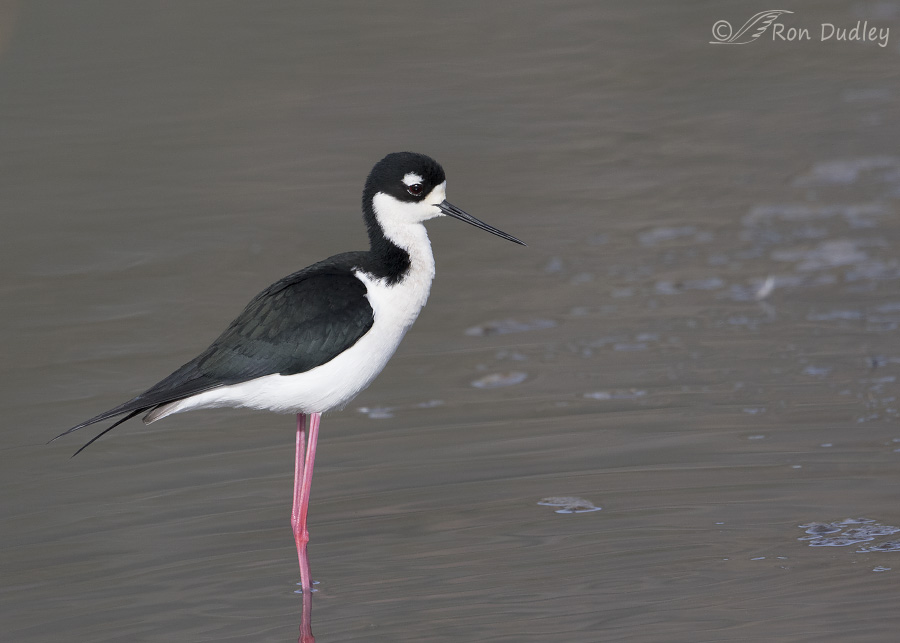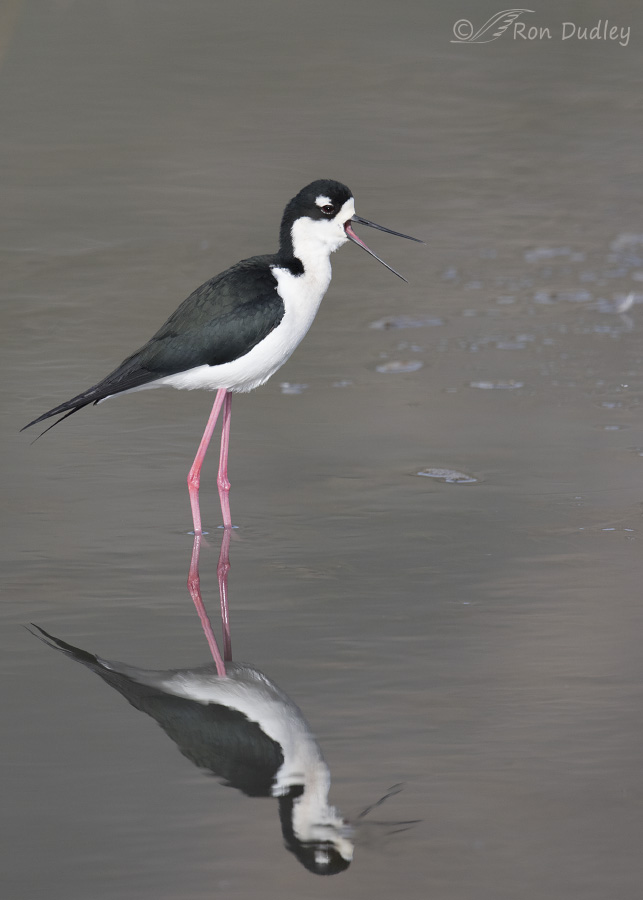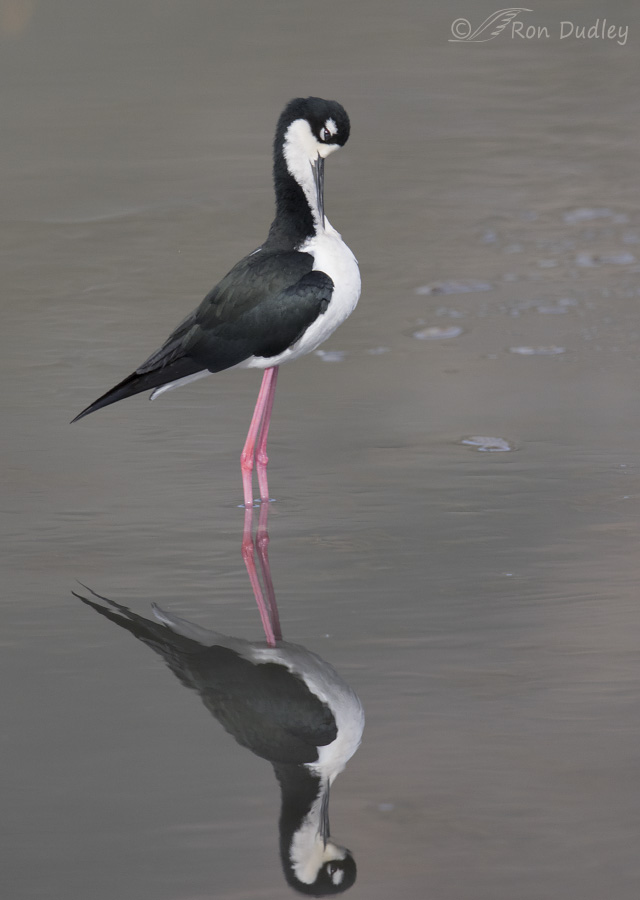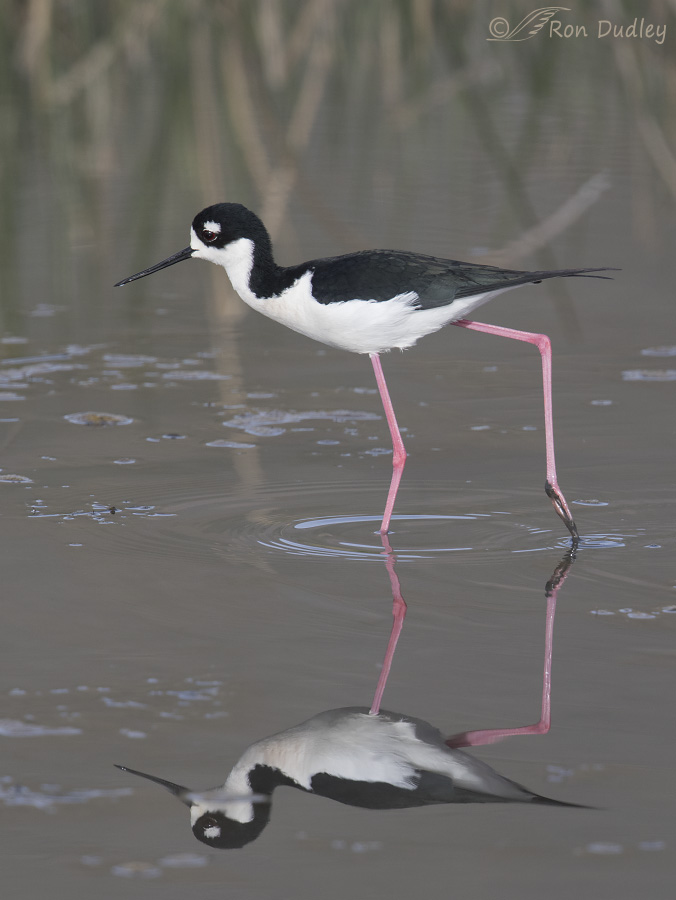I’ve seen a few Black-necked Stilts around this spring but this is the first one I’ve photographed.
 1/2000, f/6.3, ISO 500, Canon 7D Mark II, Canon EF 500mm f/4L IS II USM + 1.4 tc, not baited, set up or called in
1/2000, f/6.3, ISO 500, Canon 7D Mark II, Canon EF 500mm f/4L IS II USM + 1.4 tc, not baited, set up or called in
I found the bird three days ago in a small pond adjacent to a country road in Box Elder County, Utah. There were actually two of them in the pond but the second bird stayed mostly hidden.
The Black-necked Stilt is a study in contrasts as Birds of North America Online describes well:
- “Its shiny black wings and back oppose the white breast, and both are accentuated by long, bright red legs. Undisturbed, stilts wade through shallow wetlands and flooded fields with a careful grace. When disturbed during the breeding season, however, all semblance of grace disappears. Agitated stilts yap incessantly, dive at predators, and feign mortal injuries. After a day of field work near breeding stilts, the yapping echoes in one’s head until the next morning when the sound is renewed by the continuing calls of vigilant parents.”

1/2000, f/6.3, ISO 500, Canon 7D Mark II, Canon EF 500mm f/4L IS II USM + 1.4 tc, not baited, set up or called in
I find stilts (and American Avocets) to be somewhat unique and challenging as photographic subjects because the reflections of their extremely long legs often make it look like you’ve cut off part of the actual bird in photographs unless you include the entire reflection of both legs and body. If you’re close enough for good detail this usually means shooting vertically and photographers know how awkward and difficult it is to follow a moving bird up close when shooting vertically.
So I decided to practice that skill with this stilt (the bird is yawning, not calling).

1/2000, f/6.3, ISO 500, Canon 7D Mark II, Canon EF 500mm f/4L IS II USM + 1.4 tc, not baited, set up or called in
One of the big challenges when shooting birds vertically up close (especially from a vehicle) is to keep your camera level. If you don’t then you have to rotate during processing to get it level and that means you have to crop out a significant portion of the image. But often the portion you have to discard is needed for pleasing composition.
That’s what happened here. Before rotation I had plenty of room at the bottom for good composition but after rotation the head of the stilt was too close to the bottom of the frame for my tastes. And to be perfectly honest I had to fudge a little on the rotation to keep from clipping the top of the head in the reflection (the image isn’t quite level).

1/1250, f/6.3, ISO 500, Canon 7D Mark II, Canon EF 500mm f/4L IS II USM + 1.4 tc, not baited, set up or called in
I’m including this final image because I find the graphic lines of those pink legs and their reflections interesting.
I didn’t get any great images of this stilt that morning but I was able to practice a difficult photography skill and I have hopes that the lesson will pay off in the future.
Ron


Ha! When I initially saw the thumbnail of the first photo, I thought, “Wow, it’s not like Ron to chop the feet off in the crop.” Glad to see it was just an object lesson on shooting technique! This is a neat bird! I love how sort of dainty and ‘young’ it looks, like a cartoon bird almost. I can’t believe these haven’t been featured in some Disney film with a singing princess.
Love the final image as well, striking pink lines along with the softness of the ripples, the muddy foot, and that *teeny* drop of water on the end of the bill; gorgeous. You may say no great shots, but, I beg to differ!
What a adorable bird. All of your photos are great.
Love them all, but the third has my vote today. Though those angles look painful. And looking at the reflections I am reminded of your educative posts on the subject. Thank you for both.
Thank you, EC.
Wonderful post, Ron. I always struggle with shooting vertically. I have a much more difficult time locating a bird in the viewfinder when shooting vertically…I thought it was just my ineptitude.
No, it’s not your ineptitude, Sharon. Finding the subject in the viewfinder when shooting vertically is a completely different game. I have the same problem and I usually feel quite inadequate while I’m trying to do it – thus the practice with this bird.
Like Dick, the last one is my favorite, but they are all beautiful…particularly love the colors in this bird and the water, the delicate concentric circle pattern of the ripples, and the crispness of the reflections. These images show the “underneathness” of the belly of the bird in the reflection…the “mirroring” of the underbelly….Also love the pose and reflection of the second to last…
I like the way you “dissect” my images, Patty – being specific about what you like or catches your attention.
Those details are what makes your work so special and I about it….these things stand out….
That was supposed to say, “…and what I love about it”, but the evil one sabotaged me once again…I hope it’s happy! How things I’d like to see a pile of these in the dump!!! Would make my day!!!
Wonderful shots Beautiful bird Ron!
Charlotte
Thank you, Charlotte.
Love the pictures and “inside” to this striking bird.
I always pat myself on the back when I get a picture like this at the beach……reflection in the wet sand…..with my Iphone!!! lol..lol.
I thought I was doing good!!
Thanks so much for sharing with us. I look forward to seeing your blog each day.
Thanks very much, Carol.
Beautiful! Even if you had to crop the reflections add immensely to the photo’s. Shooting vertically is a challenge and the long lens sure doesn’t help the process! It is a beautiful bird and not one I’ve seen before.
Shooting vertically is a challenge and the long lens sure doesn’t help the process! It is a beautiful bird and not one I’ve seen before.
“the long lens sure doesn’t help the process”
Exactly, Judy! The longer the lens the more awkward and difficult it is.
Yet another bird I haven’t seen before and nice photos of it. It’s a benefit of visiting your site in that I see birds I’m not familiar with because they don’t come this far east. When I saw that first photo my initial thought was, “Wow! What a pretty and dainty little bird.” Then I read the description of a study in contrasts and had to chuckle. In some ways some birds are not much different than people. Also, thanks for the reminder of shooting vertical. I need to practice that more often as well.
“In some ways some birds are not much different than people”
An accurate observation, Dave. When stilts get riled up they’re far from what they seem at first glance.
I can imagine the difficulty. I have enough trouble shooting vertical on still subjects!
I think you did a fine job with these shots on an interesting bird. I like them all, especially the last one.
“I have enough trouble shooting vertical on still subjects”
So do I, Dick. I really don’t like to shoot vertically but sometimes that’s your only practical choice.
Nice images Ron!
Thank you, Daniel.